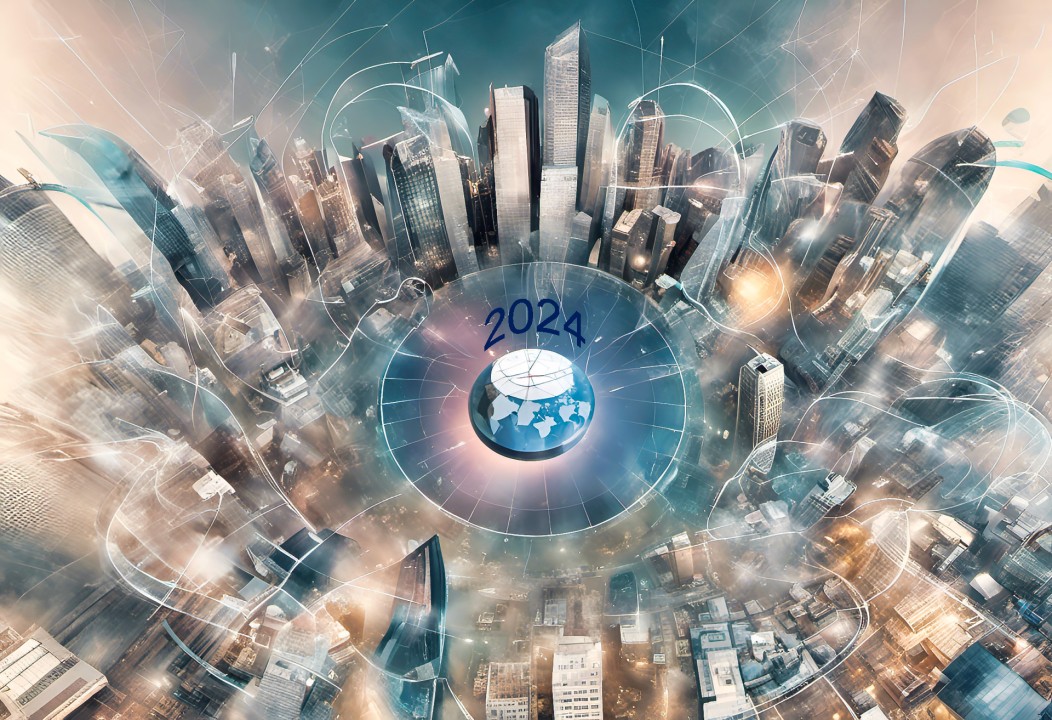
Amidst a volatile and unpredictable global landscape, India’s rise faces diverse challenges and threats that mandate comprehensive strategies and preparedness to navigate the future. An evolving India must see itself as a notable participant in the world arena, actively influencing global dynamics through diplomatic, economic, and strategic endeavours.
Concurrently, it must aspire to be a secure nation, resilient against both internal and external threats and challenges. Thus, it must aim at comprehensive development, technological advancement, social unity, democratic vitality, and intellectual influence, founded upon the principles of strategic autonomy and Aatmanirbhar Bharat. We need an India that commands respect in the world; an India that translates into an inclusive and equitable Bharat of the future.
India’s Role as Vishwa Mitra in the Spirit of Vasudhaiva Kutumbakam
The global stage is currently undergoing a challenging transition, witnessing shifts in power dynamics among nations and regions. A discernible trend toward multi-polarity is manifesting itself, as winds blow in the wrong direction for the West. Both opportunities and challenges exist for India to be a rule shaper and a key player in this multi-polarity to shape a more equitable global order.
India’s robust economic growth and heightened geopolitical influence, exemplified by a successful G-20 presidency has amplified the voices of the Global South. As India continues on its path as Vishwa Mitra (universal friend), in the spirit of Vasudhaiva Kutumbakam, sustaining the present trajectory requires a nuanced and assertive approach that remains imperative to navigate the complex dynamics of the evolving global landscape.
India must aspire to be a secure nation, resilient against both internal and external threats and challenges, coupled with comprehensive development, technological advancement, social unity and democratic vitality
Asia and the Indo-Pacific are emerging as the epicentres of the global economy and a hotspot for great power competition. Indo-Pacific poses a central challenge to regional stability, with a hegemonic China. The US emerges as India’s primary strategic partner, fostering cooperation in high technology, defence and various bilateral domains, despite some discordant elements, which make it a ‘blow hot-blow cold’ partner.
Ironically two all-weather strategic and robust partners – Russia and Israel with shared interests, and historic trust are both in conflict situations. Our support is a testing ground of astute diplomacy under adversity. We must not fail them.
India must remain vigilant, acknowledging China as the primary adversary across all domains, necessitating a proactive and holistic approach to bolster its deterrent capabilities. While Pakistan and China both create instability, their levels of threat vary. Yet the Indian response must not waver nor be dichotomous to either. Realities and actions must replace rhetoric and ambiguities. India must call a spade a spade, especially against China as it does for Pakistan.
Viksit Bharat@2047
Towards its destination of Viksit Bharat 2047, the year 2024 marks a critical path because of elections and the likely continuity of policy fostering India’s rise. Yet, the model must be inclusive and realistic to be a happiness-induced development model. The real debate centres on whether we prioritise employment and capabilities or settle for a profit-centric society content merely to be a market.
Real growth encompasses not only GDP increase but also infrastructure, supply chains, skills, finance, employment and military capabilities. While external opportunities are valuable, they should not replace the ongoing cultivation of inherent domestic strengths. The promotion of global trade and investments, a combination of information, networking, reforms and ease of doing business is imperative. Thus, heightened trade and economic activities must fortify skills, capabilities, defence and employment for inclusive growth.
Further Viksit Bharat is only possible if we have a Surakshit Bharat, with robust deterrence and responses against future multi-domain threats both external and internal. This requires an enunciated National Security Strategy supported by matching resource allocation, realigned joint structures, revisited strategies and a dynamic civil-military fusion.
The trend of politicisation of the military for policies, which have scant regard for national security must find restraint. National security is not an appeasement game for petty politics. The focus must be on preparing for and addressing the realities of the burgeoning external and internal threats dispassionately and pragmatically. A deterrence reconstruct and multi domain response capability to future threats thus merits consideration.
As India continues on its path as Vishwa Mitra in the spirit of Vasudhaiva Kutumbakam, it would require a nuanced and assertive approach to navigate the complex dynamics of the evolving global landscape
Threats and Challenges to Viksit Bharat
Population Pressures and Resource Scarcity: India’s large population presents a significant challenge to sustainable development, especially given the growing youth demographic profile. The youth bulge can be a boom or a bomb, necessitating focused attention on job creation, and fostering economic growth. The rapid urbanisation accompanying this demographic shift, along with rising demands for essential resources such as water, energy, and food, may place undue pressure on existing infrastructure and impact resource scarcity. Tackling these myriad challenges demands a comprehensive approach, involving efficient resource management, meticulous urban planning, equitable distribution, and the implementation of sustainable practices.
Environmental Degradation and Climate Change: The looming threat of environmental degradation, ecological imbalance and climate change demands immediate corrective actions. India must accelerate its transition to renewable energy sources, implement stringent environmental regulations, and promote conservation efforts to mitigate disasters and protect its ecosystems.
Inequality and Social Disparities: While India’s economic progress has been commendable, inequalities and social disparities in access to education, healthcare, and economic opportunities hinder social mobility and foster unrest. Inclusive policies to bridge these gaps, coupled with the eradication of caste-based discrimination and gender disparities, are essential for building an inclusive and harmonious society.
Technological Disruptions and Ethical Concerns: While technological advancements bring efficiencies, they also bring forth ethical dilemmas and disruptions. Rapid automation and artificial intelligence could lead to job displacement and social unrest. Additionally, concerns over data privacy, cyber security, and the ethical implications of emerging technologies need to be carefully addressed to ensure that India’s technological progress is beneficial, ethical and responsible.
Healthcare and Pandemic Preparedness: The COVID-19 pandemic underscored the importance of robust healthcare systems and effective pandemic preparedness at grassroots levels. India must invest in healthcare infrastructure, research, and disease surveillance to mitigate the impact of future health crises. Strengthening public health systems and ensuring universal access to quality healthcare will be pivotal in safeguarding the well being of its citizens.
Heightened trade and economic activities must fortify skills, capabilities, defence and employment for inclusive growth in 2024 resulting in a Viksit Bharat @2047
Navigating the Course to Future Trajectory
Astute Diplomacy and Multilateralism: India should continue to emphasise diplomacy and multilateral forums to resolve disputes and address global challenges such as climate change, environmental risks, poverty, terrorism, and sustainable development. It needs to forge strong diplomatic ties with nations across the globe through strategic partnerships, trade agreements, and cultural exchanges.
Investing in Human Capital: India’s pursuit of continued transformation necessitates substantial investments in human capital, especially in health, inclusive growth and addressing the gap between skill and educational degrees. The low per capita income and the disproportionate distribution of wealth amongst the few, need course correction. India’s position on the Human Development Index (HDI) underscores the need to tackle inequalities hindering economic growth.

Resource Scarcity and Competition: The quest for scarce resources, including energy, food, and minerals, can lead to competition and potential conflicts among nations. India must promote responsible resource management, and renewable energy adoption, and engage in cooperative agreements to mitigate resource-related inequalities.
Cyber Security and Information Warfare: Rapid technological advancements and the interconnected nature of digital networks can make nations vulnerable to cyber attacks, data breaches, and disinformation campaigns. India must invest in robust cyber security measures, international collaboration, and information sharing to protect its digital infrastructure.
Regional Conflicts and Security Threats: Ongoing regional conflicts, terrorism, and non-state actors can destabilise nations and regions. India’s role in conflict resolution, counterterrorism cooperation, and maintaining regional stability becomes crucial to prevent the spill over of conflicts into its borders.
Economic Diversification and Trade Relations: India’s economic diversification and trade partnerships should be nurtured to ensure resilience against global economic fluctuations. Balanced trade relationships and diversified investment practices can enhance economic stability.
India’s large population presents a significant challenge to sustainable development, especially given the growing youth demographic profile, which could be either a boom or a bomb
Soft Power and Cultural Diplomacy: India’s soft power, including its rich cultural heritage, should be leveraged for global outreach. Cultural exchanges, educational programmes, and people-to-people diplomacy can foster understanding and enhance India’s positive image on the global stage.
Securing India: National Security Challenges
Geopolitical Rivalries and Regional Conflicts: These pose a significant threat to India’s security. Border disputes, territorial claims, and cross-border terrorism can lead to tensions and potential military confrontations. To mitigate this challenge, India should continue to engage in diplomatic efforts, prioritise peaceful negotiations, and strengthen its defence capabilities to deter aggression.
As regards immediate neighbourhood, India seems to be losing its bonhomie with its neighbours who are increasingly being wooed by China. This loss of influence has serious implications for India’s national security calculus. More diplomatic acumen and outreach would be required to regain lost ground.
Terrorism and Insurgency: Terrorism and insurgency remain persistent threats, which could destabilise internal security and disrupt social harmony. India must enhance intelligence-sharing, cross-border cooperation, and counter-terrorism measures to prevent the infiltration of extremist groups. Thus, investing in community-based programmes for counter-radicalisation, addressing toxic ideologies and fostering international cooperation in anti-terrorism efforts is crucial.
Cyber Security and Hybrid Warfare: With the globalisation and digitisation of society, cyber threats and hybrid warfare techniques emerge as major challenges. India must strengthen its cyber security infrastructure, develop advanced technologies for defence, and enhance public awareness.
As India paves its path through the challenges and opportunities of 2024, safeguarding the nation’s future mandates a comprehensive and forward-thinking approach
Border Security and Maritime Challenges: Securing vast land, aerospace and maritime borders is a complex undertaking. Territorial threats require a tri-service integrated response more so with disputed borders at stake. Yet, oceans will take geostrategic prominence in the future. Consequently, nations must incorporate ocean geopolitics into their strategic considerations for national security and economic planning. India must invest in advanced technologies, multi domain capabilities, and collaborative efforts with neighbouring countries to ensure comprehensive land, aerospace and maritime security.
Nuclear Proliferation and Non-State Actors: The spread of nuclear weapons and the risk of them falling into the hands of non-state actors can have grave implications for national security. India should actively engage in disarmament initiatives, promote peaceful uses of nuclear energy, and strengthen its non-proliferation efforts.
Internal Security Domain: Communal and ethnic tensions pose internal security threats that jeopardise social cohesion and stability. India must prioritise inclusive governance, religious tolerance, and cultural sensitivity to address underlying grievances and prevent the escalation of violence.
As India paves its path through the challenges and opportunities of 2024, safeguarding the nation’s future mandates a comprehensive and forward-thinking approach. From national security and defence reforms to healthcare, education, and economic inclusivity, the novel choices made will resonate in India’s global narrative and Bharat’s inclusive growth. Finally, the call must remain – India First and Nation Above All.
-The author is a PVSM, AVSM, VSM has had an illustrious career spanning nearly four decades. A distinguished Armoured Corps officer, he has served in various prestigious staff and command appointments including Commander Independent Armoured Brigade, ADG PP, GOC Armoured Division and GOC Strike 1. The officer retired as DG Mechanised Forces in December 2017 during which he was the architect to initiate process for reintroduction of Light Tank and Chairman on the study on C5ISR for Indian Army. Subsequently he was Consultant MoD/OFB from 2018 to 2020. The Officer is a reputed defence analyst, a motivational speaker and prolific writer on matters of military, defence technology and national security.The views expressed are personal and do not necessarily carry the views of Raksha Anirveda.















